Comparing Current and Future Land Suitability for Growing Rainfed Corn (Zea mays) in Georgia, USA
Abstract
:1. Introduction
2. Methods
2.1. Climate Data
2.2. Topography Data
2.3. Soils Data
2.4. Corn Yield Data
2.5. Agricultural Insurance Indemnity Payment Data
2.6. Statistical Analysis
2.7. Future Climate Data
3. Results and Discussion
3.1. Land Suitability Classes for Topographic and Soil Factors
3.2. Current Land Suitability Classes Based on Climate
3.3. Validation of Current Land Suitability Classes Based on Historical Data
| Land Suitability Parameters | ||||||
|---|---|---|---|---|---|---|
| Variable | Tmean | Tmin | Tmax | Slope | Texture | pH |
| Acres Planted | 99 | 96 | 94 | 58 | 70 | 70 |
| Yield | 48 | 82 | 67 | 31 | 48 | 34 |
| % Crop Loss | 73 | 94 | 67 | 25 | 88 | 79 |
3.4. Future Land Suitability Classes Based on Climate Predictions
4. Conclusions
Supplementary Materials
Author Contributions
Funding
Data Availability Statement
Conflicts of Interest
References
- Food and Agriculture Organization of the United Nations (FAO). Land Evaluation. Towards a Revised Framework; FAO Land and Water Discussion Paper No. 6; FAO: Rome, Italy, 2007. [Google Scholar]
- Food and Agriculture Organization of the United Nations (FAO). A Framework for Land Evaluation; FAO Soils Bulletin No. 32; FAO: Rome, Italy, 1976. [Google Scholar]
- Klingebiel, A.A.; Montgomery, P.H. Land Capability Classification; USDA Agricultural Handbook 210; Soil Conservation Service, US Government Printing Office: Washington, DC, USA, 1961. [Google Scholar]
- Harms, B.; Brough, D.; Philip, S.; Bartley, R.; Clifford, D.; Thomas, M.; Willis, R.; Gregory, L. A comparative assessment of land suitability evaluation methods for agricultural land use planning at village level. Glob. Food Secur. 2015, 5, 25–36. [Google Scholar] [CrossRef]
- Kidd, D.; Webb, M.; Malone, B.; Minasny, B.; McBratney, A. Digital soil assessment of agricultural suitability, versatility and capital in Tasmania, Australia. Geoderma Reg. 2015, 6, 7–20. [Google Scholar] [CrossRef]
- Taghizadeh-Mehrjardi, R.; Nabiollahi, K.; Rasoli, L.; Kerry, R.; Scholten, T. Land suitability assessment and agricultural production sustainability using machine learning models. Agronomy 2020, 10, 573. [Google Scholar] [CrossRef]
- Ramirez-Cabral, N.Y.Z.; Kumar, L.; Shabani, F. Global alterations in areas of suitability for maize production from climate change and using a mechanistic species distribution model (CLIMEX). Sci. Rep. 2017, 7, 5910. [Google Scholar] [CrossRef] [PubMed]
- Tashayo, B.; Honarbakhsh, A.; Akbari, M.; Eftekhari, M. Land suitability assessment for maize farming using a GIS-AHP method for a semi-arid region, Iran. J. Saudi Soc. Agric. Sci. 2020, 19, 332–338. [Google Scholar] [CrossRef]
- Bagherzadeh, A.; Mansouri Daneshvar, M.R. Qualitative land suitability evaluation for wheat and barley crops in Khorasan-Razavi province, northeast of Iran. J. Agric. Res. 2014, 3, 155–164. [Google Scholar] [CrossRef]
- Pilevar, A.H.; Matinfar, H.R.; Sohrabi, A.; Sarmadian, F. Integrated fuzzy, AHP and GIS techniques for land suitability assessment in semi-arid regions for wheat and maize farming. Ecol. Indic. 2020, 110, 105887. [Google Scholar] [CrossRef]
- Dang, K.B.; Burkhard, B.; Windhorst, W.; Müller, F. Application of a hybrid neural-fuzzy inference system for mapping crop suitability areas and predicting rice yields. Environ. Model. Softw. 2019, 119, 301–312. [Google Scholar] [CrossRef]
- Grassano, N.; Tedone, L.; Verdini, L.; De Mastro, G. Evaluation of rapeseed cultivation suitability in Apulia with GIS-multicriteria analysis. Ital. J. Agron. 2011, 6, e16. [Google Scholar] [CrossRef]
- Ostovari, Y.; Honarbakhsh, A.; Sangoony, H.; Zolfaghari, F.; Malekie, K.; Ingram, B. GIS and multi-criteria decision-making analysis assessment of land suitability for rapeseed farming in calcareous soils of semi-arid regions. Ecol. Indic. 2019, 103, 479–487. [Google Scholar] [CrossRef]
- Zhang, J.; Su, Y.; Wu, J.; Liang, H. GIS based land suitability assessment for tobacco production using AHP and fuzzy set in Shandong province of China. Comput. Electron. Agric. 2015, 114, 202–211. [Google Scholar] [CrossRef]
- Zhu, Q.; Wang, F.; Yi, Q.; Zhang, X.; Chen, S.; Zheng, J.; Li, J.; Xu, T.; Peng, D. Modeling soybean cultivation suitability in China and its future trends in climate change scenarios. J. Environ. Manag. 2023, 345, 130124. [Google Scholar] [CrossRef]
- Zhu, Y.; Sun, L.; Luo, Q.; Chen, H.; Yang, Y. Spatial optimization of cotton cultivation in Xinjiang: A climate change perspective. Int. J. Appl. Earth Obs. Geoinf. 2023, 124, 103523. [Google Scholar] [CrossRef]
- Feizizadeh, B.; Blaschke, T. Land suitability analysis for Tabriz County, Iran: A multi-criteria evaluation approach using GIS. J. Environ. Plan. Manag. 2012, 56, 1–23. [Google Scholar] [CrossRef]
- Ziadat, F.M. Land suitability classification using different sources of information: Soil maps and predicted soil attributes in Jordan. Geoderma 2007, 140, 73–80. [Google Scholar] [CrossRef]
- Zolekar, R.B.; Bhagat, V.S. Multi-criteria land suitability analysis for agriculture in hilly zone: Remote sensing and GIS approach. Comput. Electron. Agric. 2015, 118, 300–321. [Google Scholar] [CrossRef]
- El Baroudy, A.A. Mapping and evaluating land suitability using a GIS-based model. Catena 2016, 140, 96–104. [Google Scholar] [CrossRef]
- Kazemi, H.; Akinci, H. A land use suitability model for rainfed farming by Multi-criteria Decision Making Analysis (MCDA) and Geographic Information System (GIS). Ecol. Indic. 2018, 116, 1–6. [Google Scholar] [CrossRef]
- Halder, J.C. Land suitability assessment for crop cultivation by using remote sensing and GIS. J. Geogr. Geol. 2013, 5, 65–74. [Google Scholar] [CrossRef]
- Mustafa, A.A.; Singh, M.; Sahoo, R.N.; Ahmed, N.; Khanna, M.; Sarangi, A.; Mishra, A.K. Land suitability analysis for different crops: A multi criteria decision making approach using remote sensing and GIS. Researcher 2011, 3, 61–84. [Google Scholar]
- Mosleh, Z.; Salehi, M.H.; Fasakhodi, A.A.; Jafari, A.; Mehnatkesh, A.; Borujeni, I.E. Sustainable allocation of agricultural lands and water resources using suitability analysis and mathematical multi-objective programming. Geoderma 2017, 303, 52–59. [Google Scholar] [CrossRef]
- Phillips, S.J.; Anderson, R.P.; Schapire, R.E. Maximum entropy modeling of species geographic distributions. Ecol. Model. 2006, 190, 231–259. [Google Scholar] [CrossRef]
- Lomolino, M.V.; Riddle, B.R.; Whittaker, R.J. Biogeography. Biological Diversity across Space and Time, 5th ed.; Sinauer Associates: Sunderland, MA, USA, 2016. [Google Scholar]
- Reynolds, M.P.; Ortiz, R. Adapting Crops to Climate Change: A Summary. In Climate Change and Crop Production; CABI: Wallingford, UK, 2010; pp. 1–8. [Google Scholar]
- Schneider, J.M.; Zabel, F.; Mauser, W. Global inventory of suitable, cultivable and available cropland under different scenarios and policies. Sci. Data 2022, 9, 527. [Google Scholar] [CrossRef] [PubMed]
- Yue, Y.; Zhang, P.; Shang, Y. The potential global distribution and dynamics of wheat under multiple climate change scenarios. Sci. Total Environ. 2019, 688, 1308–1318. [Google Scholar] [CrossRef]
- Guo, X.; Zhang, P.; Yue, Y. Prediction of global wheat cultivation distribution under climate change and socioeconomic development. Sci. Total Environ. 2024, 919, 170481. [Google Scholar] [CrossRef] [PubMed]
- Lu, F.; Wang, H.; Ma, X.; Peng, H.; Shan, J. Modeling the current land suitability and future dynamics of global soybean cultivation under climate change scenarios. Field Crop. Res. 2021, 263, 108069. [Google Scholar]
- Skendžić, S.; Zovko, M.; Pajač Živković, I.; Lešić, V.; Lemić, D. The impact of climate change on agricultural insect pests. Insects 2021, 12, 440. [Google Scholar] [CrossRef] [PubMed]
- Medina, A.; Rodriguez, A.; Magan, N. Effect of climate change on Aspergillus flavus and aflatoxin B1 production. Front. Microbiol. 2014, 5, 348. [Google Scholar] [CrossRef]
- FDA. 2015. Available online: http://www.fda.gov/ICECI/ComplianceManuals/CompliancePolicyGuidanceManual/ucm074703.htm (accessed on 1 August 2016).
- Battilani, P.; Toscano, P.; Van der Fels-Klerx, H.J.; Moretti, A.; Camardo Leggieri, M.; Brera, C.; Rortais, A.; Goumperis, T.; Robinson, T. Aflatoxin B1 contamination in maize in Europe increases due to climate change. Sci. Rep. 2016, 6, 24328. [Google Scholar] [CrossRef]
- Kerry, R.; Ingram, B.; Garcia-Cela, E.; Magan, N.; Ortiz, B.V.; Scully, B. Determining future aflatoxin contamination risk scenarios for corn in Southern Georgia, USA using spatio-temporal modelling and future climate simulations. Sci. Rep. 2021, 11, 13522. [Google Scholar] [CrossRef]
- Kerry, R.; Ingram, B.; Orellana, M.; Ortiz, B.V.; Scully, B. Development of a method to assess the risk of aflatoxin contamination of corn within counties in Southern Georgia, USA using remotely sensed data. Smart Agric. Technol. 2023, 3, 100124. [Google Scholar] [CrossRef]
- Mendas, A.; Delali, A. Integration of MultiCriteria Decision Analysis in GIS to develop land suitability for agriculture: Application to durum wheat cultivation in the region of Mleta in Algeria. Comput. Electron. Agric. 2012, 83, 117–126. [Google Scholar] [CrossRef]
- Thomson, A.M.; Calvin, K.V.; Smith, S.J.; Kyle, G.P.; Volke, A.; Patel, P.; Delgado-Arias, S.; Bond-Lamberty, B.; Wise, M.A.; Clarke, L.E.; et al. RCP4.5: A pathway for stabilization of radiative forcing by 2100. Clim. Chang. 2011, 109, 77–94. [Google Scholar] [CrossRef]
- Schwalm, C.R.; Glendon, S.; Duffy, P.B. RCP8.5 tracks cumulative CO2 emissions. Proc. Natl. Acad. Sci. USA 2020, 117, 19656–19657. [Google Scholar] [CrossRef] [PubMed]
- Conrad, O.; Bechtel, B.; Bock, M.; Dietrich, H.; Fischer, E.; Gerlitz, L.; Wehberg, J.; Wichmann, V.; Böhner, J. System for automated geoscientific analyses (SAGA) v. 2.1.4. Geosci. Model Dev. 2015, 8, 1991–2007. [Google Scholar] [CrossRef]
- Harris, G. Fertilization. In Corn Production in Georgia; Bryant, C., Ethredge, R., Eds.; University of Georgia College of Agricultural and Environmental Sciences, University of Georgia Extension: Athens, GA, USA, 2022. [Google Scholar]
- Bryant, C. 2020 Corn Production in Georgia. In Corn Production in Georgia; Bryant, C., Ethredge, R., Eds.; University of Georgia College of Agricultural and Environmental Sciences, University of Georgia Extension: Athens, GA, USA, 2022. [Google Scholar]
- Purdue Extension. Precipitation Requirements. Available online: https://www.extension.purdue.edu/extmedia/nch/nch-40.html (accessed on 13 July 2024).
- Prostko, E.P. Weed Management in Field Corn 2022 Agronomic Practices for Corn. In Corn Production in Georgia; Bryant, C., Ethredge, R., Eds.; University of Georgia College of Agricultural and Environmental Sciences, University of Georgia Extension: Athens, GA, USA, 2022. [Google Scholar]
- Kerry, R.; Ortiz, B.; Ingram, B.R.; Scully, B.T. A spatio-temporal investigation of risk factors for aflatoxin contamination of corn in Southern Georgia, USA using geostatistical methods. Crop Prot. 2017, 94, 144–158. [Google Scholar] [CrossRef]
- Yoo, E.; Kerry, R.; Ingram, B.R.; Ortiz, B.; Scully, B. Defining and characterizing aflatoxin contamination risk areas for corn in Georgia, USA: Adjusting for collinearity and spatial correlation. Spat. Stat. 2018, 28, 84–104. [Google Scholar] [CrossRef]
- Bryant, C. Agronomic Practices for Corn. In Corn Production in Georgia; Bryant, C., Ethredge, R., Eds.; University of Georgia College of Agricultural and Environmental Sciences, University of Georgia Extension: Athens, GA, USA, 2022; Available online: https://grains.caes.uga.edu/content/dam/caes-subsite/grains/docs/corn/2022-Corn-Production-Guide.pdf (accessed on 27 August 2024).



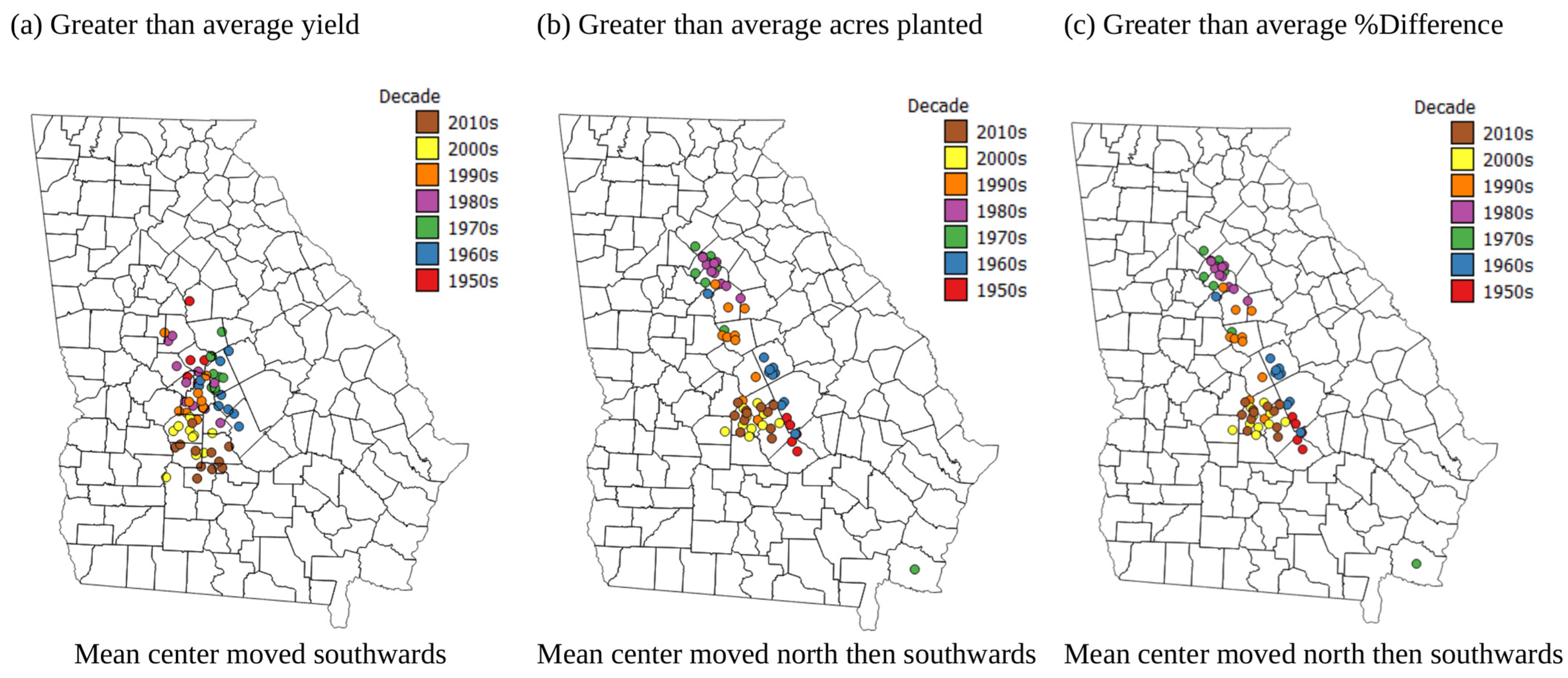
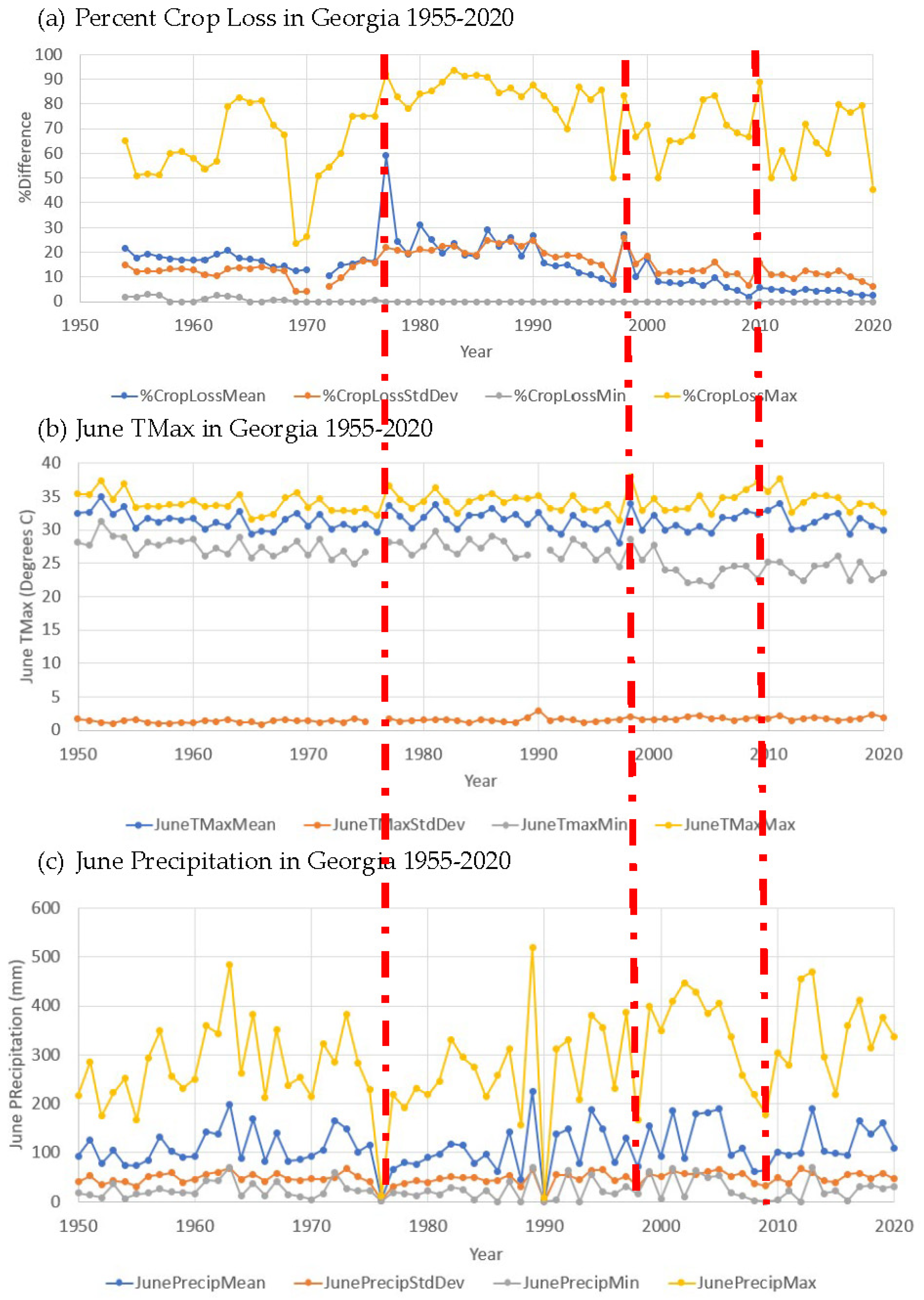
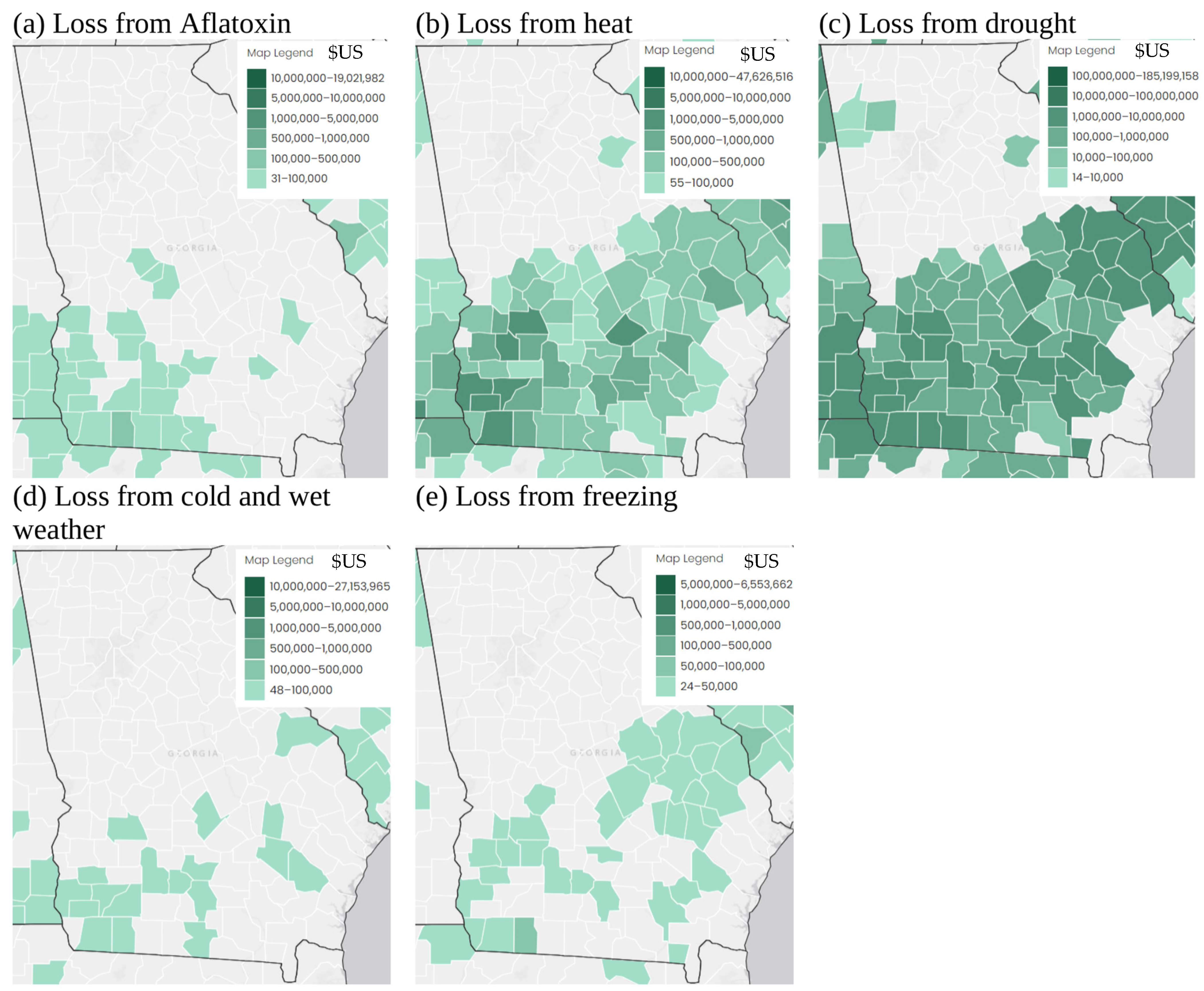
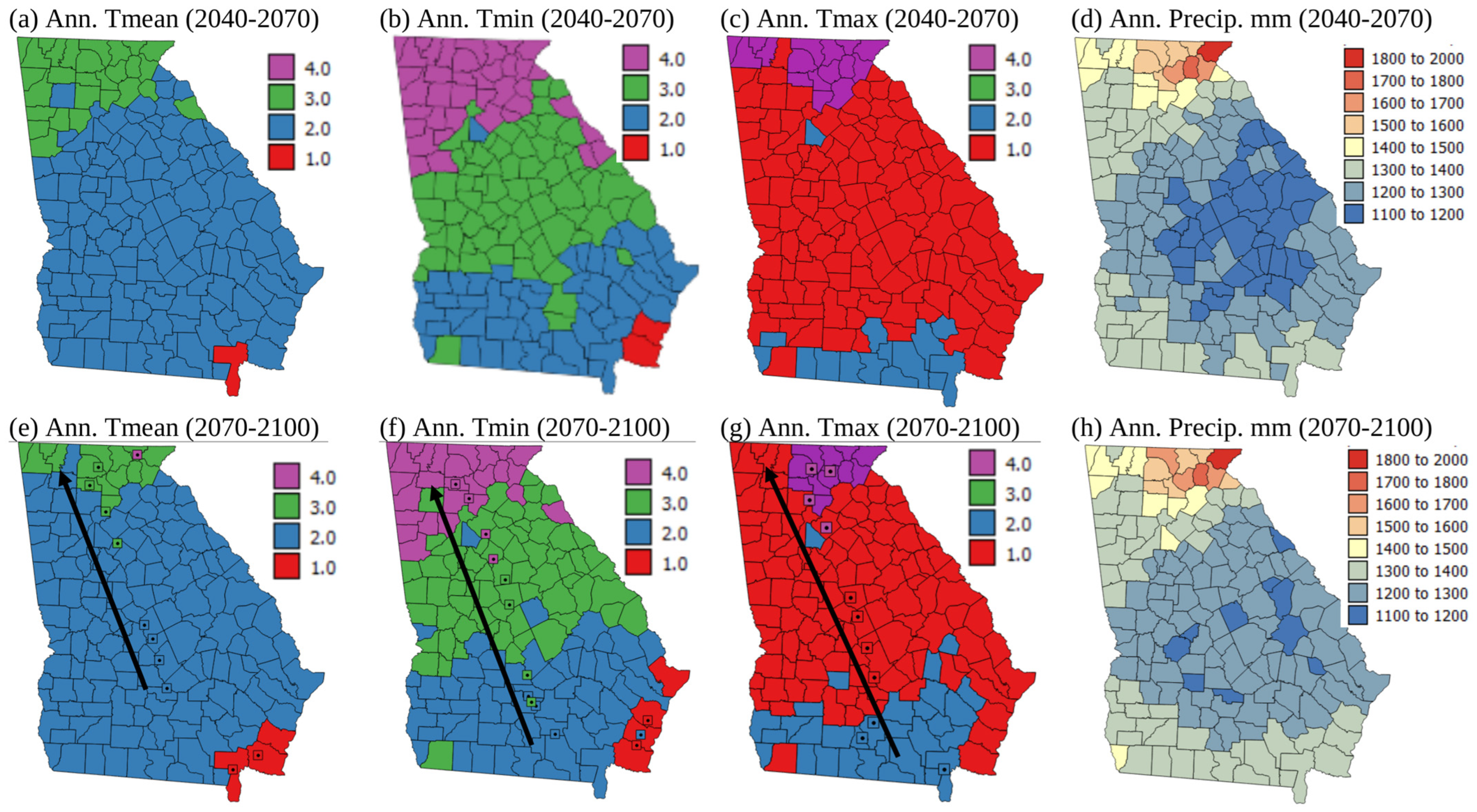
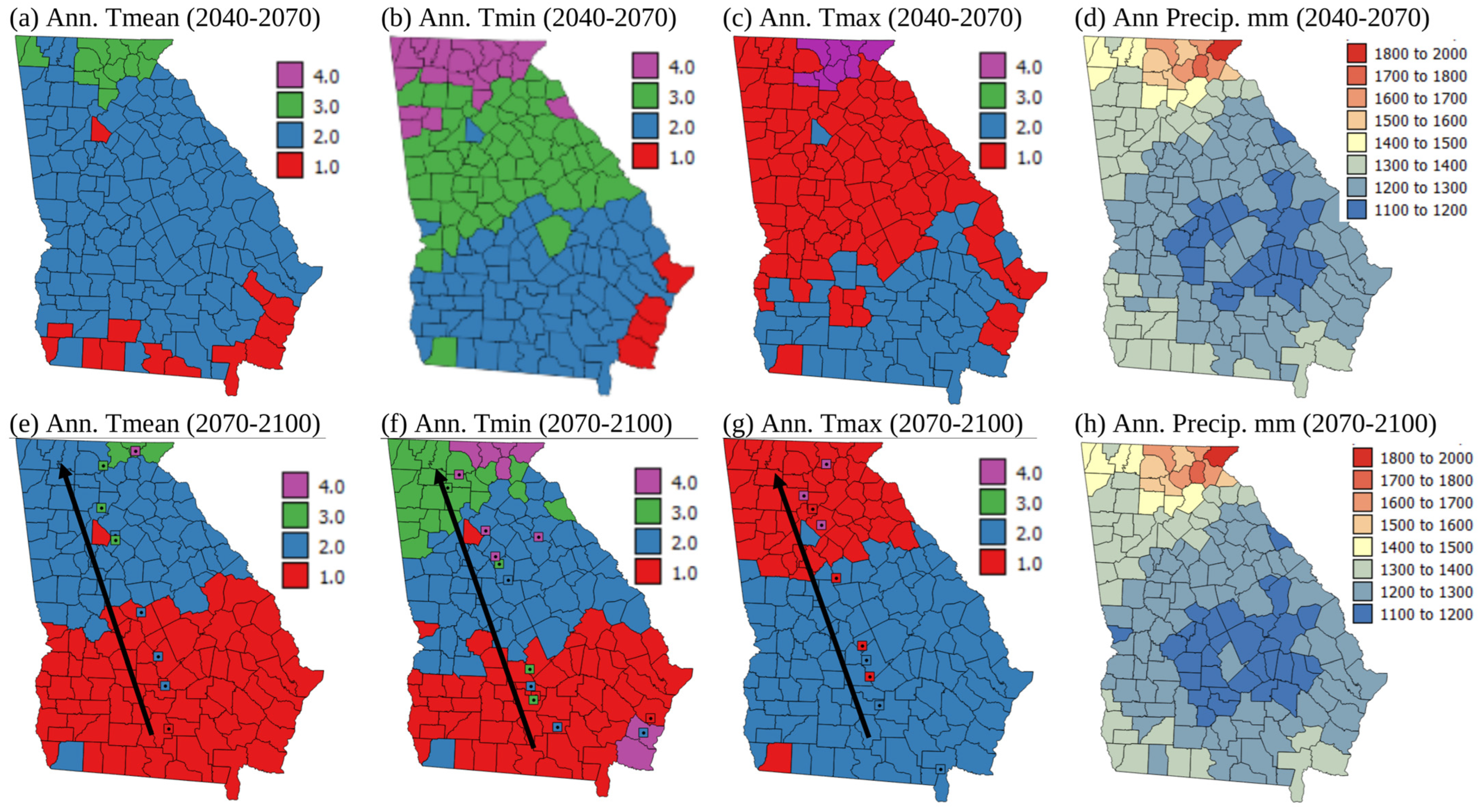
| Parameters | Highly Suitable | Moderately Suitable | Marginally Suitable | Not Suitable |
|---|---|---|---|---|
| (S1) | (S2) | (S3) | (N4) | |
| Climate factors | ||||
| Annual Tmean (°C) | 22–26 | 18–22 and 26–32 | 14–18 and 32–35 | <14 and >35 |
| Annual Tmin (°C) | 16–18 | 14–16 | 14–12 | <12 |
| Annual Tmax (°C) | 24–28 | 28–32 | 32–36 | >36 |
| Topog. factors | ||||
| Elevation (m) | <1700 | 1700–2000 | 2000–2300 | >2300 |
| Slope (%) | 0–2 | 2–6 | 6–12 | >12 |
| Soil factors | ||||
| pH | 6.5–7.5 | 5.8–6.5 and 7.5–7.8 | 5.5–5.8 and 7.8–8.2 | <5.5 and >8.2 |
| Soil texture | L, CL, SC, C | SL, SCL | LS, ZL, SCL | ZC, S, Z |
Disclaimer/Publisher’s Note: The statements, opinions and data contained in all publications are solely those of the individual author(s) and contributor(s) and not of MDPI and/or the editor(s). MDPI and/or the editor(s) disclaim responsibility for any injury to people or property resulting from any ideas, methods, instructions or products referred to in the content. |
© 2024 by the authors. Licensee MDPI, Basel, Switzerland. This article is an open access article distributed under the terms and conditions of the Creative Commons Attribution (CC BY) license (https://creativecommons.org/licenses/by/4.0/).
Share and Cite
Kerry, R.; Ingram, B.; Golden, C.S. Comparing Current and Future Land Suitability for Growing Rainfed Corn (Zea mays) in Georgia, USA. Plants 2024, 13, 2486. https://doi.org/10.3390/plants13172486
Kerry R, Ingram B, Golden CS. Comparing Current and Future Land Suitability for Growing Rainfed Corn (Zea mays) in Georgia, USA. Plants. 2024; 13(17):2486. https://doi.org/10.3390/plants13172486
Chicago/Turabian StyleKerry, Ruth, Ben Ingram, and Connor S. Golden. 2024. "Comparing Current and Future Land Suitability for Growing Rainfed Corn (Zea mays) in Georgia, USA" Plants 13, no. 17: 2486. https://doi.org/10.3390/plants13172486






